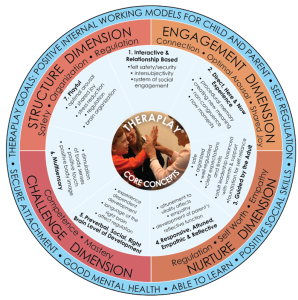Watch the You Can Adopt video
Find out more about Theraplay and how it can enhance your relationship with your child.

Would you like to feel closer and more connected to your child? At Family Adoption Links, our colleagues have a breadth of experience in different therapies so that we can help you and your child/children where necessary. In this article Lianne Graham-Halford gives us an insight into Theraplay, a concept developed over 50 years ago and practiced worldwide.
Theraplay was developed to support healthy child/caregiver attachment. Strong attachment between the child and the important adults in their life has long been believed to be the basis of lifelong good mental health as well as the mainstay of resilience in the face of adversity. Modern brain research and the field of neuroscience have shown that attachment is the way in which children come to understand, trust and thrive in their world.
Theraplay is a structured form of play therapy supporting parents and children to feel more connected. The aim is to enhance attachment, self-esteem and trust in others.
It works by regulating the lower brain stem which supports a child’s emotional regulation. The promotion of touch in Theraplay is unique and there is lots of evidence which shows how Theraplay can really help children gain more emotional regulation.
Theraplay is useful for a wide variety of children, including those who are withdrawn, depressed, over active, aggressive, have phobias or find difficulty in socialising. Children with learning disabilities and developmental delays also benefit hugely from Theraplay. Because of its focus on attachment it has been often used in the area of adoption.
Theraplay uses playful, fun games, developmentally challenging activities and tender, nurturing activities to encourage attachment. The interactions are personal, physical and fun – a natural way for everyone to experience the healing power of being together. The very act of engaging each other in this way helps the parent regulate the child’s behavior and communicate love, joy, and safety to the child. It helps the child feel secure, cared for, connected and worthy.
Theraplay interactions focus on four essential qualities found in healthy parent-child relationships:
Structure – The adult, the leader in the relationship, creates organisation and predictability for the child which communicates safety
Nurture – The adult cares and can calm and soothe the child in a manner that makes them feel good physically and emotionally
Engagement – The adult is present in a manner that the child experiences being seen, heard, felt, and accepted
Challenge – The adult supports the child in the acquisition and mastery of new skills, enhancing the child’s sense of competence and confidence
Here’s some brilliant examples of Theraplay games
Parent and child should sit facing each other, aiming for eye contact wherever possible
Caring for ouchies
Notice any bruises, if there aren’t any count or notice freckles, carefully rub in lotion (pick/choose lotion with child before the session) something with a fragrance, do hands, arms, feet, legs if child will let you. Could also count fingers and toes as you would with a baby – take delight in the child.
Pop Cheeks
Blow out your cheeks “as big as chipmunk” and have your child pop your cheeks (use side of thumbs rather than pointy fingers as these can hurt!) then do the same with your child. Repeat as many times as the child enjoys. Should be fun/joyful.
Sticker Match
Buy some little stickers before starting to play the game. Focus is on turn taking, you choose a sticker to put on your child, it could be on their face, hand, knee etc. The child then chooses a sticker to decorate you with in the same place. If you have a mirror you could look at yourselves together in the mirror and take delight in how lovely you both look. You could also touch stickers, so cheek to cheek, nose to nose, hand to hand.
Blow Over
Sit facing your child holding hands or cradle them in your lap and have them ‘blow you over’. Parents fall back whilst child blows, Once the child understands the game parents can blow the child over, you can do big puffs that will definitely blow them over and smaller puffs that might not.
Pop the Bubble
You hold and blow the bubbles and tell your child to pop them with a particular body part – hand, finger, elbow or handclap. You can vary the speed, telling the child to pop them as quickly as they can but also slow it down.
Copying/Mirroring Game
Snuggle up with your child on your lap and a cosy blanket then play the copying game, make this facially orientated, you touch your own nose and the child then copies you. You could even sing along to help guide them eg “Follow me touch your nose” “Follow me touch your mouth” “Follow me touch your ears…”
Feeding
With your child still wrapped up and on your lap, ask your partner (if you have one, if not do it yourself) to feed your child. Small Cadbury animals biscuits work well (you can talk about the animals) or marshmallows (great for calming sucking reflux if they are encouraged to suck on marshmallow rather than bite/chew) and a have a drink ready drink in Sippy cup or sports type bottle. Parents feeds biscuits/marshmallows to the child one at a time. The child can also have a drink, but parents should hold the bottle. This gives such a lovely opportunity for nurturing. Remember to give lots of eye contact where possible and imagine the child as a much younger child.
Like to know more? Here are a few great videos to support and guide you through some activities…